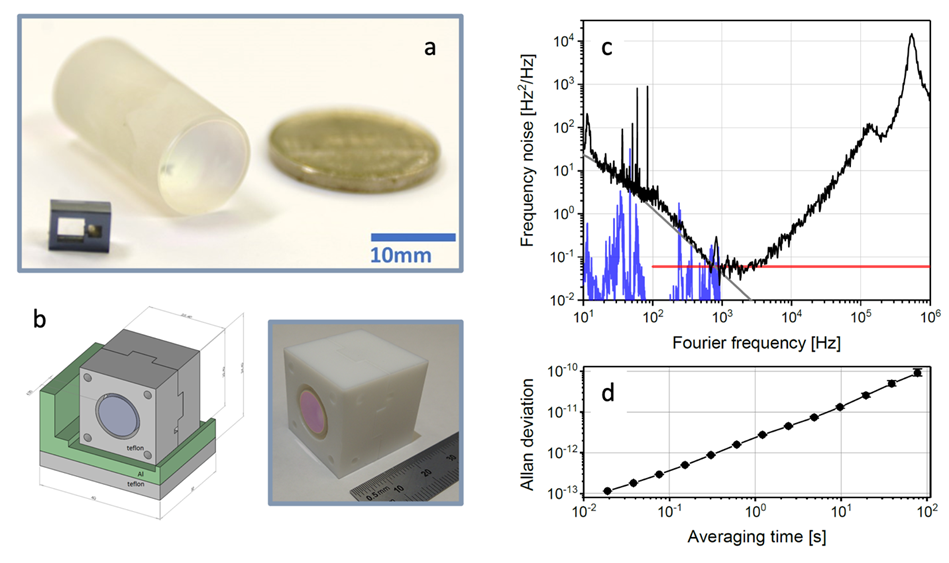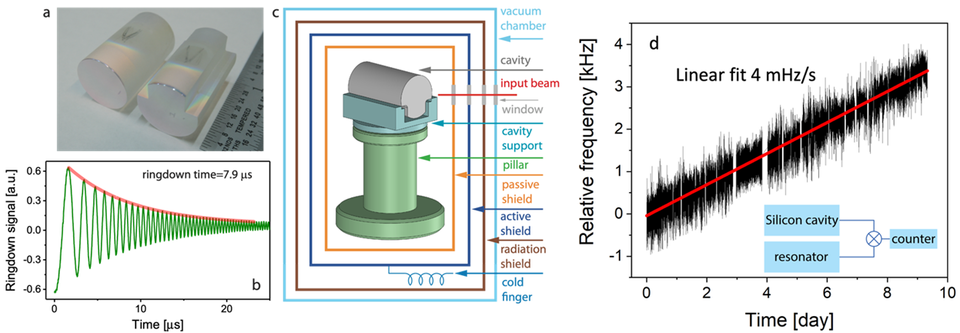Summary
Our research focuses on miniaturized laser sources with narrow linewidth that can operate in ambient environments. Lasers with high spectral purity can enable a diverse application space, including precision spectroscopy, coherent high-speed communications, physical sensing, and manipulation of quantum systems. Our team develops photonic resonators with ultrahigh quality factor by way of a fabless manufacturing process, and we explore their use in precision laser stabilization, compact atomic clocks, and sensing applications with magnetic fields.
Description
Lasers with high spectral purity are used in a diverse application space, including coherent high-speed communications, physical sensing, and manipulation of quantum systems. Lab bench scale Fabry-Perot cavities based on sophisticated vibration, thermal, and atmospheric isolation have made possible dramatic achievements in laser-linewidth reduction and sensing capability. Still, there is increasing requirement for miniaturized laser systems operating with high performance in ambient environments and with scalable manufacturing.
We explore a compact and robust photonic resonator technology to realize high finesse (>100,000) Fabry-Perot cavities through a fabless manufacturing process. The absence of an evacuated center bore, which is essential in traditional cavity systems, simplifies our system by eliminating the need for vacuum. Vibration-immune design is mandatory to reduce vibration-induced frequency fluctuations. We achieve this goal by a novel design of the cavity holding structure for a net vibration sensitivity of ≈ 10−10g−1 where g is earth’s gravity. We use the Pound-Drever-Hall technique to servo control a laser onto resonance of the cavity. The cavity supports short-term stability reaching 1 × 10−13 at 𝜏 = 20 ms, leading to 25 Hz integrated linewidth. This level of noise performance is entirely limited by intrinsic thermodynamic fluctuations that alter the cavity’s length due to the temperature sensitivity of index of refraction.
Furthermore, we demonstrate a compact and robust photonic-atomic laser comprising a 2.5 centimeter long, 20 000 finesse, monolithic Fabry–Perot cavity integrated with a micromachined rubidium vapor cell. By leveraging the short-time frequency stability of the cavity and the long-time frequency stability of atoms in a micromachined rubidium vapor cell, an ultranarrow-linewidth laser that enables integration for extended measurements is realized. Specifically, the laser supports a fractional-frequency stability of 1 × 10−13 at an averaging time of 20 millisecond, 7 × 10−13 at 300 second, an integrated linewidth of 25 Hz that results from thermal noise, frequency noise floor as low as 0.06 Hz2 Hz−1, and passive vibration immunity. Our work explores hybrid laser systems with monolithic photonic and atomic packages based on physical design.

Our photonic resonator technology offers the opportunity to optimize device properties by design of the materials and geometry just like with integrated photonics on-chip. With this system, we stabilize the frequency of a laser with respect to the cavity resonance of our device, attaining narrow linewidth and low frequency drift of the laser. We have developed photonic resonators with ultrahigh finesse greater than 100,000 by selection of the lowest loss fused silica material and application of suitable reflection coatings on the resonator end faces. Moreover, we have demonstrated specialized geometries that minimize the effect of vibration on the resonator’s optical frequency. Our photonic resonator platform also enables optimization for laser stabilization by relative design of index of refraction and the mechanical properties of the device. In particular, we balance temperature sensitivity of frequency with index of refraction and resonator length to yield temperature-insensitive behavior. Hence, through design of refractive index and resonator length, we can mitigate temperature induced drift. We report on a cryogenic photonic resonator, made of solid fused silica. We explore a null in the resonator’s frequency sensitivity at a temperature of 9.5 K, enabling laser stabilization with a long-term drift of 4 mHz/s. This fractional frequency drift rate of 10-17/s represents comparable or improved performance over conventional technologies that require much more complicated design and construction. Such cryogenic operation of the photonic resonator for laser stabilization is an important advantage, leveraging the bulk device and its robustness.

Publications
[1] W. Zhang, F. Baynes, S. A. Diddams, and S. B. Papp, Microrod Optical Frequency Reference in the Ambient Environment, Phys. Rev. Applied 12, 024010 (2019).
[2] L. Stern et al., Direct Kerr Frequency Comb Atomic Spectroscopy and Stabilization, Science Advances 6, eaax6230 (2020).
[3] L. Stern et al., Ultra-Precise Optical-Frequency Stabilization with Heterogeneous III–V/Si Lasers, Opt. Lett., OL 45, 5275 (2020).
[4] W. Zhang, L. Stern, D. Carlson, D. Bopp, Z. Newman, S. Kang, J. Kitching, and S. B. Papp, Ultranarrow Linewidth Photonic-Atomic Laser, Laser & Photonics Reviews 14, 1900293 (2020).
Major Accomplishments
- Development of ultrahigh finesse, monolithic Fabry-Perot cavity technology that is useful for laser stabilization, magnetic-field sensing, and high resolution optical filtering of classical and quantum states.
- Operation of laser stabilization to the photonic resonator at the thermal noise floor.
- Demonstration of a photonic-atomic laser with Allan deviation of 7 × 10−13 at 300 second.

